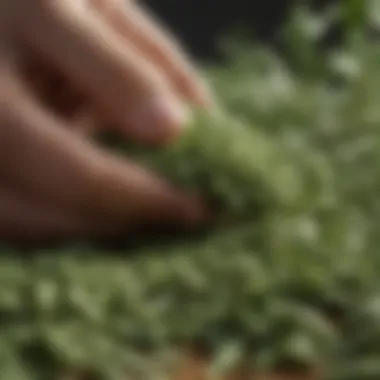The Importance of Stine Enlist Soybeans in Agriculture


Intro
In the landscape of today's agricultural practices, certain crop types stand out due to their adaptability and impact on farming methods. One such player in this arena is Stine Enlist Soybeans. These soybeans are not simply another variety; they symbolize a fusion of genetic advancement and agricultural sustainability. The evolution of agricultural demands necessitates a closer look at how these soybeans fit into modern farming paradigms.
Understanding Stine Enlist Soybeans involves grasping their unique characteristics, the innovative technologies that support them, and the potential benefits they bring to crop rotation systems. Additionally, there are broader market trends at play that influence the adoption of these soybeans among farmers. This article aims to explore these dimensions to provide a comprehensive understanding of the role that Stine Enlist Soybeans play in contemporary agriculture.
Prelude to Stine Enlist Soybeans
Stine Enlist soybeans play a significant role in today’s agricultural landscape. Understanding these soybeans involves exploring their unique traits and the benefits they offer to farmers and agronomists. This introductory section aims to outline the importance of these specific soybeans, emphasizing how they contribute to modern farming practices and their relevance in a world increasingly focused on sustainability and innovation.
Definition and Background
Stine Enlist soybeans refer to a specific variety of genetically modified soybeans developed by Stine Seed Company. These beans are engineered to withstand certain herbicides, namely glyphosate and 2,4-D. This trait is particularly essential as it provides farmers with the ability to control weed populations more effectively, which is crucial for maximizing yield potential in soybean farming. Herbicide-resistant crops allow for more efficient weed management strategies, preventing farmers from facing substantial crop losses due to weed competition.
The genetic modification of Stine Enlist soybeans encompasses advanced agricultural biotechnology. In a market where efficiency and productivity are key, these genetic traits are critical for meeting rising global food demands. The introduction of herbicide tolerance enables farmers to apply herbicides directly to the plants without harming them, which simplifies weed control and encourages healthier crop growth.
Historical Context of Soybean Cultivation
Soybeans have been cultivated for thousands of years, with their origins tracing back to ancient China. Over time, they have evolved from being a minor crop to a major component of global agriculture. The domestication of soybeans in the early 20th century paved the way for their spread into the Americas. By the 1950s, soybean cultivation in the United States began to rise significantly, leading to its eventual status as one of the country's most important cash crops.
With the advent of biotechnology, the approach to soybean cultivation transformed dramatically. The introduction of genetically modified organisms, especially in the late 1990s, sparked a debate about the safety and sustainability of such crops. Stine Enlist soybeans represent a continuation of that evolution – responding to challenges like weed resistance, climate change, and the need for more sustainable agricultural practices. The creation of these soybeans is not simply a technological feat but also a response to farmers’ real-world challenges, attempting to strike a balance between productivity and environmental impact.
The historical journey of soybeans illustrates the critical role they play in global food systems today. As farmers face increasing pressures from pests, diseases, and environmental constraints, the development of soybeans like the Stine Enlist variety provides a promising avenue for overcoming these hurdles, ensuring that agriculture continues to meet the needs of a growing population.
Genetic Innovations in Stine Enlist Soybeans
In a world where the agricultural landscape is continually evolving, the genetic innovations in Stine Enlist Soybeans play a critical role in shaping modern farming practices. These innovations are not merely a scientific fad; they represent a significant leap towards meeting the ever-increasing global demand for sustainable and resilient crops. Through genetic engineering, Stine Enlist Soybeans have undergone transformations that enhance their robustness against pests and diseases while also increasing their adaptability to varying agricultural conditions.
Transgenic Development
The hallmark of Stine Enlist Soybeans lies in their transgenic development, a process which involves the introduction of specific traits into the soybean genome. This is achieved by incorporating genes that confer desirable attributes, such as herbicide tolerance and pest resistance. The outcome is a soybean variety that is better suited to withstand the pressures of contemporary agriculture.
One striking example of this development is the introduction of the Enlist trait, allowing these soybeans to thrive even in the presence of certain herbicides. This trait not only simplifies weed management but also mitigates the reliance on mechanical weeding, which can be labor-intensive and costly. According to reports, the yield advantage seen in Stine Enlist varieties is compelling, allowing for more efficient use of land and resources.
Farmers are no longer forced to tread that fine line between crop protection and yield loss. Instead, they can focus their efforts on maximizing productivity without the looming threat of aggressive weed species. The transgenic aspect of these soybeans is not just a passing trend; it’s a necessity in a climate where food security becomes increasingly vital.
Herbicide Resistance Mechanisms
The herbicide resistance mechanisms in Stine Enlist Soybeans further bolster their position in modern agriculture. This unique feature is significant in the context of Integrated Pest Management (IPM) practices, which aim to create sustainable and environmentally friendly cultivation methods. By designing soybeans that can withstand specific herbicides, farmers are empowered with more tools to control weed populations without resorting to broad-spectrum herbicides that can affect non-target plant species.
"Herbicide resistance not only optimizes weed control but also lowers the risk of herbicide resistance developing in weed species themselves."
This targeted resistance reduces the chances of weed species adapting and evolving resistance strategies, which has become a growing concern in agriculture today. Moreover, it allows for a more flexible cropping system, where farmers can adopt different management practices tailored to their specific fields without compromising their harvest yields.
In practice, the adoption of Stine Enlist Soybeans translates to a more efficient agricultural output. Farmers report not only reduced input costs but also enhanced soil health due to decreased soil disturbance and better crop rotation possibilities. This is increasingly important as the agricultural community pivots towards practices that align with sustainability goals, echoing a broader shift towards stewardship of natural resources.
As the landscape of soybean cultivation continues to change, the genetic innovations encapsulated in Stine Enlist Soybeans serve as a beacon of hope for those invested in agriculture. By bridging the gap between technology and traditional farming, these soybeans offer a compelling case for the future of crop production.
Agronomic Benefits of Stine Enlist Soybeans
Stine Enlist Soybeans are increasingly becoming vital in modern agriculture, and their agronomic benefits cannot be overlooked. As growers grapple with challenges like pest pressures, weed resistance, and the push for sustainable farming practices, Stine Enlist Soybeans stand out as a robust option. Understanding their advantages helps farmers make informed decisions that ultimately impact their yields and profitability.
Yield Potential and Market Competitiveness


The yield potential of Stine Enlist Soybeans is one of their hallmark features. Compared to traditional soybean varieties, these genetically modified crops boast traits that can significantly enhance productivity. For instance, Stine Enlist varieties often have better tolerance to harsh environmental conditions, such as drought or flooding, which is essential when considering fluctuating climates. This resilience can translate directly into higher yields—a critical factor for farmers looking to remain competitive in a saturated market.
Moreover, robust genetic advancements mean that seed selections are continually improving, ensuring that farmers have access to cutting-edge agronomic traits. Preliminary studies have shown yield increases ranging from 5% to 15% compared to older varieties. This increase could be the difference between profit and loss in today's economy.
In terms of market competitiveness, having a strong yield potential directly correlates with better market prices. Farmers can more confidently invest in Stine Enlist production, knowing they have a product that can meet or exceed market demand. Pricing for soybeans can also exhibit fluctuations based on supply and quality. Varieties like Stine Enlist, which can yield more consistently, often lead to favorable pricing outcomes—an aspect no farmer can afford to ignore.
Impact on Soil Health and Biodiversity
The importance of soil health in agriculture cannot be overstated, and Stine Enlist Soybeans bring notable benefits to this dimension. These soybeans can contribute positively to soil health through enhanced nutrient uptake and improved soil structure. Healthy roots from Stine Enlist varieties promote better aeration and water infiltration, which in turn supports soil microorganisms essential for nutrient cycling.
Improving soil health also aligns with wider agricultural sustainability goals. A strong focus on biodiversity can lead to more resilient ecosystems. In crop rotations, the incorporation of Stine Enlist Soybeans can help break pest cycles, ultimately reducing pesticide applications. This promotes healthier farming environments, not just for crops but for the surrounding flora and fauna as well.
"Integrating Stine Enlist Soybeans into farming systems underscores the necessity of balancing productivity with ecological robustness."
Furthermore, with the herbicide-resistant features of Stine Enlist, farmers can adopt more integrated weed management strategies. This trait not only aids in weed control but also allows for less herbicide application, which is beneficial for both soil quality and farmer profitability. In an era where sustainable practices are increasingly valued, the ecological advantages of Stine Enlist Soybeans position them favorably within agricultural discourse.
Challenges in Cultivation
The cultivation of Stine Enlist Soybeans, while promising a plethora of benefits, is not without its hurdles. Understanding these challenges is crucial for farmers and agronomists who aim to maximize yield while navigating the complexities of modern agriculture. Issues such as pest resistance, regulatory hurdles, and fluctuating market conditions can significantly impact the practicality and profitability of these soybean varieties.
Resistance Management Strategies
One of the primary challenges in cultivating Stine Enlist Soybeans is effectively managing resistance to herbicides and pests. As farmers increasingly rely on these genetically modified varieties, there's a growing concern about potential resistance development among weed and pest populations. This phenomenon is not novel in agriculture; it’s reminiscent of past instances observed in cotton and corn cultivation facing similar issues.
To mitigate this risk, various management strategies can be employed, such as:\n
- Integrated Weed Management (IWM): This approach combines different control methods, including mechanical, cultural, and chemical practices. For instance, rotating herbicides with different modes of action can help prevent weeds from developing resistance.
- Crop Rotation: Alternating Stine Enlist Soybeans with non-GMO crops can disrupt pest and weed life cycles, reducing their populations and the potential for resistance.
- Scouting and Monitoring: Regular crop evaluations to identify early signs of pest infestations or weed pressure allow for timely intervention, making management more effective.
Implementing these strategies not only helps in managing resistance but also supports a sustainable farming approach, ensuring that farmers can continue to cultivate soybeans effectively over the long term.
Regulatory and Market Barriers
Another significant hurdle faced by growers of Stine Enlist Soybeans is navigating the regulatory landscape. Different nations have varying regulations regarding genetically modified organisms (GMOs), which can pose substantial challenges for farmers. For instance, in certain markets, stringent labeling laws or import restrictions may limit the ability of farmers to sell their crops.
This is compounded by market perceptions. Consumer attitudes towards GMOs can fluctuate, impacting demand. Farmers may find themselves facing unfavorable pricing dynamics if consumers lean towards non-GMO products. To tackle this, engaging with local communities and educating consumers about the benefits of genetically modified soybeans can help shift perceptions.
Additionally, some strategies to handle these regulatory and market barriers include:\n
- Participating in Dialogue: Engaging with policymakers to advocate for more transparent and reasonable regulations can be beneficial for growers.
- Diversification of Crops: Growing a mix of soybean varieties, both GMO and traditional, may help farmers hedge against market fluctuations and varying consumer preferences.
- Documentation and Transparency: Keeping clear records of practices and being open about processes can bolster consumer trust and potentially facilitate market access.
Adapting to these challenges requires foresight and flexibility, emphasizing the need for farmers to remain well-informed about the evolving landscape of agricultural regulations and market dynamics.
"Understanding challenges in cultivation is not just about survival; it's about thriving in the complex world of modern agriculture."
Farmers who proactively address these issues will not only safeguard their immediate interests but also contribute toward a more robust and sustainable agricultural sector.
Comparative Analysis with Other Soybean Varieties
The exploration of different soybean varieties is crucial for understanding how Stine Enlist Soybeans stack up against their traditional and genetically modified counterparts. This section sheds light on not just their genetic differences, but also the practical implications these differences hold for farmers, agronomists, and the agricultural industry at large.
Traditional vs. Genetically Modified Varieties
When we pit traditional soybean varieties against genetically modified ones like Stine Enlist, several factors come into play.


- Genetic Traits: Traditional varieties have been bred through selective breeding techniques over generations, focusing on traits such as yield and disease resistance. In contrast, Stine Enlist Soybeans have been enhanced through transgenic methods, allowing for herbicide resistance and enhanced resilience against pests. This difference can be a game-changer, especially in fields where traditional crops might falter under pest pressure or weed competition.
- Farming Practices: Farmers cultivating traditional soybeans often face challenges relating to pest and weed management, which can lead to increased labor and costs. On the other hand, Stine Enlist's herbicide-tolerant traits facilitate easier weed management, lessening the dependency on manual labor and allowing for more efficient use of resources. This can lead to a less intensive farming regimen that many operators could find appealing.
- Market Acceptance: There's also the aspect of consumer perceptions regarding genetically modified organisms (GMOs). While some markets are more accepting of GMOs, others remain firmly rooted in traditional agricultural products. Understanding these market dynamics is key for farmers deciding which varieties to plant.
Cost-Benefit Considerations
Engaging in a cost-benefit analysis is fundamental when evaluating Stine Enlist Soybeans in comparison to other varieties.
- Initial Investment: Genetically modified seeds typically come with a higher upfront cost. Farmers must weigh this against the potential increase in yield and savings on herbicides throughout the growing season. However, the long-term savings on labor and input costs can make Stine Enlist a worthwhile investment.
- Yield Output: Several studies have indicated that while traditional soybeans may have steady yield outputs, the advancements seen in genetically modified options like Stine Enlist often lead to higher yields, especially in challenging agricultural conditions. This could mean a higher profit margin for farmers over several growing seasons.
- Risk Management: Another layer to consider is risk management. Traditional varieties can be susceptible to various environmental and biological stressors, leading to inconsistent harvests. Genetically modified soybeans offer a buffer against some of these risks, potentially providing more stable returns year after year.
"Deciding between traditional and genetically modified soybeans isn't merely a preference—it's a strategic choice that influences a farmer's operational efficiency and economic stability."
As the agricultural landscape continues to evolve, understanding these variables becomes increasingly significant. Each farmer must assess factors such as local climate conditions, market demands, and their own operational capabilities to make informed decisions that best suit their agricultural goals.
The Role of Stine Enlist Soybeans in Sustainable Farming
Stine Enlist Soybeans represent a significant leap in sustainable farming practices. In the current landscape of agriculture, the pressing need for solutions that balance productivity with environmental stewardship has never been greater. At the heart of this movement are the benefits these soybeans offer, which contribute to the sustainability goals of modern agriculture.
Stine Enlist Soybeans, through their unique genetic modifications, provide an avenue to reduce chemical inputs while maximizing yield potential. This is particularly vital in a field where the loss of arable land and the impact of climate change become everyday concerns. By enhancing herbicide resistance, these soybeans can thrive even in challenging conditions, reducing the necessity for more toxic herbicides that can cause ecological harm.
"Sustainable farming requires innovation that remains sensitive to ecological balance while addressing production demands."
Integration in Crop Rotations
The practice of integrating Stine Enlist Soybeans into crop rotations is an effective strategy for enhancing soil health and promoting biodiversity. Historically, farmers have rotated soybeans with corn and wheat, but the introduction of Stine Enlist varieties adds a new dimension to these practices.
Advantages of incorporating these soybeans include:
- Nutrient replenishment: Soybeans naturally fix nitrogen in the soil, benefiting subsequent crops.
- Pest management: Crop rotation can disrupt pest cycles, reducing infestations.
- Weed suppression: Their herbicide-resistant traits allow for effective weed management without the excessive use of chemicals, leading to a more balanced ecosystem.
This integration not only bolsters productivity but also fosters ecological resilience. It’s a practical way of ensuring that the soil remains fertile for future generations, addressing both today’s farming challenges and tomorrow’s needs.
Environmental Impact Assessments
As agriculture faces increasing scrutiny regarding its environmental impact, Stine Enlist Soybeans offer a compelling case for assessment. Evaluating the environmental footprint of these crops is crucial in understanding their role in sustainable agriculture.
Several key areas emerge in these assessments:
- Reduction of chemical runoff: The efficiency of herbicide use can potentially limit runoff into nearby waterways, promoting healthier aquatic ecosystems.
- Biodiversity support: By allowing farmers to manage weeds effectively without harming beneficial insects, these soybeans can foster a richer biological community.
- Soil conservation: With improved soil health from proper crop rotation involving Stine Enlist Soybeans, erosion rates could decline significantly.
While these beans come with a set of challenges, the overall trajectory is gearing towards positive environmental outcomes. Continuous impact assessments can guide effective practices and new innovations in cycles that foster sustainability.
By embracing Stine Enlist Soybeans in sustainable farming, we're not just cultivating crops—we're nurturing the earth for the long haul.
Market Trends and Economic Implications
The role that Stine Enlist Soybeans play in modern agriculture is not merely confined to genetic advancements or agronomic benefits; it extends into the realm of market trends and economic implications. The current agricultural landscape is heavily influenced by market dynamics, which include demand fluctuations, pricing strategies, and trade relations. Understanding these facets is crucial for stakeholders who aim to leverage the advantages of Stine Enlist Soybeans.
One key factor to consider is how the global demand for soybeans directly impacts farmers' willingness to invest in different varieties. Rising demand can encourage shifts in cultivation practices, as farmers look to capitalize on potential profit margins. This is especially pertinent for soybeans engineered to be more resilient, such as Stine Enlist, which can offer a competitive edge in a crowded marketplace.
Global Demand for Soybeans
In recent years, there has been a marked increase in the global demand for soybeans, spearheaded by several influential markets. Countries like China and Brazil have realized the nutritional benefits of soybeans, leading to increased import activity. This demand doesn’t merely revolve around soybean consumption as food but extends to its use in livestock feed, biofuel production, and even industrial applications.
To break it down:


- China's Appetite: The Chinese market is voracious when it comes to soybean imports, often sourcing vast quantities from the United States and Brazil. The growing middle class in China has contributed to a consistent increase in the intake of protein-rich diets, further escalating the demand for soybeans.
- Trend in Livestock Production: As there is a worldwide push for protein-rich diets, livestock production spikes consequently. Soybeans, being a primary source of protein feed, directly benefit from this trend.
- Sustainability Goals: An upsurge in biofuel production requirements has made soybeans even more valuable. Countries aiming to reduce carbon emissions often turn to renewable energy sources, and soybean-derived biodiesel fits the bill.
The global demand, then, does not just serve economic purposes; it plays a key role in food security and sustainability, making it essential for farmers to remain attuned to these trends.
Pricing Dynamics and Trade Relations
The pricing of soybeans is deeply intertwined with global trade relations and agricultural policies. Prices can fluctuate wildly based on various factors, including crop yield, export tariffs, and geopolitical tensions. Farmers must navigate these complexities to optimize their economic potential.
An understanding of these dynamics can be beneficial:
- Volatile Pricing: The pricing of soybeans often mirrors larger economic conditions. A drought can lead to decreased yields, driving up prices, while a bumper crop might lead to market saturation, causing prices to plummet.
- Impact of Trade Policies: The political landscape, including trade tariffs, plays a significant role in constructing the pricing framework. For instance, tariffs imposed by China on U.S. soybeans can create economic ripples, affecting what farmers receive for their crops.
- Local vs. Global Pricing: Farmers must also consider how local market prices compare with international benchmarks. If local prices are lower than those in global markets, it might prompt a reevaluation of cultivation strategies.
"Understanding the pricing dynamics and global trade relations is vital for the effective management of soybean production and commercialization."
To sum up, market trends and economic implications demand the same level of scrutiny as other agricultural processes. The sustainable demand for soybeans, particularly varieties like Stine Enlist, sets the stage for an evolving agricultural paradigm. Each stakeholder, from farmers to agronomists, must keep a finger on the pulse of these shifting trends to navigate successfully and make informed decisions.
Future Perspectives and Innovations
These days, the world of agriculture is becoming more intricate and crucial as we face pressing issues like climate change and growing populations. Stine Enlist Soybeans are right at the heart of these challenges, not just offering promise today but also paving the way for future farming practices. This section explores how advancements in technology and innovative practices are set to reshape soybean cultivation and what that means for farmers and agronomists alike.
Emerging Technologies in Soybean Agriculture
Emerging technologies are making waves in soybean agriculture, enhancing productivity and sustainability. From precision agriculture to biotechnology, these cutting-edge methods provide new ways to boost yield while being environmentally friendly. For example:
- Drone Technology: Used for monitoring crops, drones can gather data on crop health, moisture levels, and nutrient needs, helping farmers make informed decisions.
- Genomic Editing: Techniques like CRISPR-Cas9 enable breeders to create more resilient soybean varieties that can withstand pests and diseases, trimming down reliance on chemical treatments.
- Soil Health Monitoring: Innovative sensors can track soil moisture and nutrient levels, providing real-time feedback for better crop management.
- Artificial Intelligence: AI-driven algorithms can predict pest outbreaks, helping farmers act before problems escalate, ultimately conserving resources.
Adopting these new technologies requires a shift in mindset. Farmers will need to embrace these tools to stay competitive. It's like changing the engine in a classic car; it’s still the same vehicle, but it now runs more smoothly and efficiently.
Predictions for Soybean Cultivation Trends
Looking forward, several trends offer valuable insights into the future of soybean cultivation. These predictions are influenced by a combination of consumer demand, environmental pressures, and advances in agricultural science:
- Increased Demand for Sustainable Practices: Consumers are becoming more environmentally conscious. They want assurances that their food is produced sustainably. Thus, farmers who adopt practices that minimize their carbon footprints can take advantage of this growing market.
- Diversification of Crop Systems: There will be a rising trend toward integrating soybeans with other crops in crop rotations. This not only helps in pest control but also enhances soil health by balancing nutrient usage.
- Consumer Preferences: More and more, consumers are leaning towards food produced without synthetic herbicides and pesticides. This creates opportunities for Stine Enlist Soybeans, given their resilience and ability to thrive with less chemical intervention.
- Adaptation to Climate Change: With weather patterns becoming increasingly unpredictable, soybeans that can withstand drought or flooding will be more valuable. Seed innovation will play a crucial role in developing those characteristics.
"Adapting to change is not just necessary; it’s the only way to survive in agriculture."
In essence, the agricultural landscape is on the edge of major transformation. The future embodies both challenges and opportunities, with Stine Enlist Soybeans positioned as a hallmark of progress and resilience. By leveraging emerging technologies and preparing for evolving trends, farmers can prepare themselves for a more sustainable and productive future.
Endings and Recommendations
In the field of modern agriculture, the significance of Stine Enlist Soybeans cannot be understated. This article assessed the multifaceted roles of these soybeans, touching upon genetic innovations, agronomic benefits, and their sustainable integration within various farming practices. As farmers and agronomists sift through the wealth of information regarding Stine Enlist Soybeans, it becomes vital to distill key insights and actionable strategies, guiding subsequent cultivation decisions.
Summarizing Key Insights
Understanding the characteristics of Stine Enlist Soybeans reveals several advantages:
- Enhanced Yield Potential: These soybeans have been engineered for high productivity, often translating to greater profits for farmers.
- Herbicide Resistance: Their ability to resist multiple herbicide formulations simplifies weed management, reducing labor and herbicide costs.
- Sustainability Considerations: Integrating Stine Enlist into crop rotations can lead to improved soil health while also supporting biodiversity in agricultural ecosystems.
Moreover, it’s evident there are challenges, including regulatory hurdles and resistance management strategies that require careful consideration. Keeping these factors in check ensures the continued viability of this variety in various agricultural contexts.
Guidelines for Farmers and Agronomists
For those who wish to implement Stine Enlist Soybeans in their operations, several recommendations arise:
- Conducting Soil Tests: Before planting, it’s crucial to understand soil health and nutrient levels to maximize yield.
- Implementing Integrated Pest Management: Employ diverse strategies for pest control to prevent resistance buildup, ensuring longevity of effectiveness.
- Monitoring Market Trends: Stay updated on pricing dynamics and global demand shifts to align planting decisions with favorable economic conditions.
- Educating on Herbicide Use: Familiarize yourself with the specific herbicides that Stine Enlist soybeans can tolerate, and rotate herbicide classes to mitigate resistance.
- Engaging in Research: Explore ongoing research regarding environmental impacts and production techniques to stay ahead of industry changes.
Effective integration of Stine Enlist Soybeans necessitates an informed approach, balancing innovation with sustainable practices.
By embracing these recommendations, farmers and agronomists not only improve operational efficiency but also contribute to the evolution of agricultural practices that are both economically viable and ecologically sound. As they cultivate their fields with an eye on the future, understanding the implications of their choices will be instrumental in driving both productivity and sustainability in agriculture.



